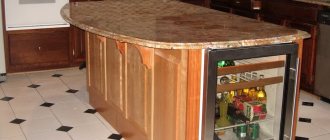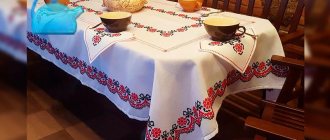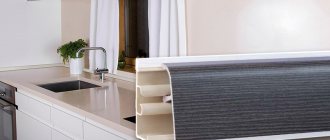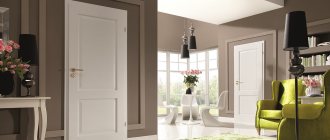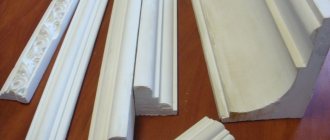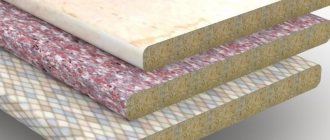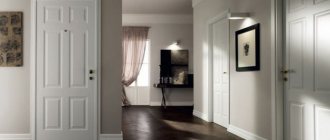The calling card of any renovation is the junction nodes, the way one material or surface passes into another, for example, the joint between a countertop and an apron. The quality of the repair is how well it is done. A kitchen plinth is an element for finishing the junction between the apron and the countertop; another name for it is molding.
There is a huge range of kitchen edges, ranging from budget options made of plastic to expensive ones made of artificial or natural stone. In this material, we will analyze in detail the functionality, what kitchen moldings exist, what their features are, how they fit into the backsplash, how to install them, and whether they are even needed in modern renovations.
Article navigation:
|
Functions of kitchen plinths
The purpose of a kitchen plinth is similar to the purpose of its floor counterpart. The kitchen edge serves for correct joining without a gap between the countertop and the apron, which is used to decorate the working surface of the wall. This element performs the following functions:
- Protecting the seam between the tabletop and the apron from drops and crumbs. It often happens that kitchen elements do not fit tightly against the wall. This occurs due to curvature, deviations from the vertical or horizontal of the load-bearing surfaces. Residues of food and crumbs can get into the resulting gap, which in the future become a source of unpleasant odor. Protection from water is necessary for countertops made of wood and wood-derived materials, such as chipboard, fiberboard, MDF and the like. When exposed to moisture on the open end, the material may swell. If you cover the joint with molding, this will protect the tabletop from contact with water, and it will last much longer.
- The design of a kitchen baseboard can complement the interior of the kitchen and backsplash. Its presence makes the space complete and harmonious. In part, the kitchen edge hides finishing defects, for example, a chip in the tile on the backsplash or a defect on the countertop. If there is a small gap of up to 20mm between the kitchen and the wall, then the molding will close it. It is also indispensable when installing a glass apron: the skinali is aligned with the upper cabinets, and the gap below, usually 2-5 mm, is closed with a plinth.
- lighting can be implemented in the wall rim. There is a large selection of models with space inside for wires and LED strips. Such lighting is used as an additional light source or as an emergency light.
Unusual replacement options
Creative individuals have long guessed that a variety of materials can be used instead of skirting boards, including the following ideas:
- Tempered glass or ceramic strip. The decor is strong and durable, and is also sealed, which allows it to be used in the bathroom. More often it is monochromatic, sometimes with an ornament. Glass border elements are secured using transparent silicone glue.
- Jute rope. An original, but not very practical replacement option. Not suitable for all styles, but combines well with wood trim. The rope reliably blocks joints and increases thermal insulation.
Harmony of jute rope Source postila.ru
Shape and size of kitchen plinth
The form of the side is developed by the designers of the manufacturer. When choosing the right option, you should pay attention to compliance with the style of the kitchen. Based on their shape, kitchen plinths can be divided into several types:
Triangular is the most common type of kitchen molding, which has become a classic. A product of this shape has an internal right angle, on the sides of which there are holes for fastening to a tabletop or wall. Hypotenuse - the front strip has a decorative surface and snaps into place after fixing the internal fastening part. Skirting boards of this shape can be made from any material.
Rounded - a type of triangular, which also has an internal right angle. The front, decorative part is convex and rounded.
Square and rectangular - a stylish option for a kitchen in a modern design. As a rule, aluminum products have such a variety of shapes.
Flat ones are a kind of compromise between a full-size plinth and its absence. It is used when it is necessary to close a small gap of a couple of millimeters between the tabletop and the skin. At high heights they can be used instead of an apron.
Curly e (fillet) is another type of triangular skirting boards. They are characterized by figured elements on the decorative part: bends, grooves and protrusions. Most often found among wooden sides.
Kitchen edges are sold in lengths up to 5 meters. The exact size can be obtained from the supplier. For successful installation, they must be purchased with a reserve so that there are as few joints as possible on the baseboard itself.
The width and height of kitchen moldings may vary significantly between different models. For example, there are plastic skirting boards 5mm high and 30mm wide.
Plastic countertop repair
To remove cracks and chips, you can use a special fastening glue for plastic, which is applied with a gun. If the surface is not badly damaged, regular superglue will do. To cover the flaws, the plastic is ground to a powdery mass and mixed with glue. The resulting mass is used to fill the chips.
Additional Information! For large tables it is worth buying Titan glue.
The width and height of kitchen moldings may vary significantly between different models. For example, there are plastic skirting boards 5mm high and 30mm wide.
The calling card of any renovation is the junction nodes, the way one material or surface passes into another, for example, the joint between a countertop and an apron.
The quality of the repair is how well it is done. A kitchen plinth is an element for finishing the junction between the apron and the countertop; another name for it is molding. There is a huge range of kitchen edges, ranging from budget options made of plastic to expensive ones made of artificial or natural stone. In this material, we will analyze in detail the functionality, what kitchen moldings exist, what their features are, how they fit into the backsplash, how to install them, and whether they are even needed in modern renovations. Article navigation:
Choosing a kitchen plinth for the skinali
If you are the happy owner of a custom-made kitchen, then most likely the kitchen plinth was included in the project by the designer. This means that your furniture set already has a border for the apron. It's possible that for some reason you want to replace the entire baseboard or countertop and just need new molding.
Below are tips for choosing a kitchen plinth so that it copes with its functions, fits harmoniously into the interior and maintains an excellent appearance for a long time.
Match the color and material of the countertop
One approach to choosing a plinth says: the side should be taken from the same material and color as the tabletop. For example, a stone countertop - stone plinth, wooden - wooden, laminated - plastic in color. If you couldn’t find one from the same material or your budget is limited, then you can look for the most suitable option among plastic moldings, among which there is the largest selection of colors.
For kitchen fittings
The second approach says: the baseboard should be matched to the color of the fittings in the kitchen, sink, railing and other accessories. For example, a gold rim will go well with gold handles and rails, and an aluminum version will go well with a matte stainless steel sink.
General Tips
When ordering a kitchen set along with a countertop, immediately select the appropriate baseboard; this will allow you to order them together in one batch and there will be less likelihood of color differences.
For each type of side there is a recommended installation method, which is better to find out in advance. Some models are glued, some are screwed to the tabletop with self-tapping screws, and some are screwed to the wall. In addition, there are combined installation methods: on sealant and on furniture nails at the same time.
If there is a large gap between the apron and the countertop, you should carefully consider the width of the kitchen plinth - it should cover this gap with a small margin so that it can be fixed to the work surface. The wider the gap, the larger the width of the plinth.
When using a gas hob, it is better to use heat-resistant baseboard options.
When installing a glass apron on a countertop made of natural or artificial stone, the best result is achieved when the plinth is placed after the apron. The order is as follows: installation of the countertop - installation of the apron - installation of the baseboard.
Metallic profile
Also called tile nesting corner.
It closes the gap between the wall and the countertop without the use of sealant. Look great paired with a gray countertop, stainless steel sink or chrome faucet. To mount the profile, you must first install the kitchen, then secure the corner. Only after this should you begin tiling the apron with ceramic tiles.
In addition to metal profiles, corners are made from plastic: they are more flexible, making it possible to mask wall unevenness. But such products look cheap, so if you have ordered an expensive kitchen, we recommend not spoiling its appearance with a budget solution.
Apron without baseboard
After reading all of the above, the reader may think: there are so many complexities and nuances with the plinth - maybe without it at all? Yes, this is possible, but subject to a number of conditions:
- The tabletop must be installed strictly level, the permissible deviation is no more than 0.5mm
- the joint between the countertop and the apron in the kitchen should not exceed 1mm
How to install a kitchen plinth?
You can install kitchen plinths yourself. The process is not difficult if you approach the matter thoughtfully and without unnecessary fuss.
Procedure:
- Check the presence of all elements of the kitchen molding in the required quantity and tools: whips, corner, end and joining elements (if necessary), sealant, fasteners (screws or nails), tape measure, pencil, hacksaw or miter saw, screwdriver (if installed on self-tapping screws) , hammer (if installed on nails), sealant gun.
- Measure the required length of the plinth, taking into account the joining and end elements.
- Cut to the required length. The rule here is: measure seven times, cut once. The extra 10mm can be cut off, but it will not be possible to increase it.
- Apply sealant to the joint between the countertop and the apron.
- Install the side on the sealant and secure it using a suitable method: screws, nails, staples, etc. It is important that when fixing the baseboard, it must fit snugly to the countertop and wall.
- Similarly, assemble the side along the entire length of the kitchen and install corner, end and connecting elements.
Ceramic border
An interesting solution for those who are not afraid to combine styles and a variety of materials. A slightly protruding border from the same collection as the backsplash tiles will become a barrier to moisture and beautifully decorate the joint with the countertop.
In order for the side to adhere as closely as possible to the elements, it is necessary to use silicone sealant - transparent or in the color of the material.
The border will decorate a kitchen in country and Provence style, and will be appropriate in eclecticism and even in a classic interior.
